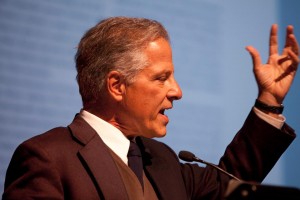by James A. Bacon
WEST PALM BEACH, FLA–Since its genesis three decades or so ago, the New Urbanism movement looked to the 1920s as the golden era of urban development in the United States. City builders had adapted to the rise of the automobile as dominant transportation mode while retaining continuity with previous urban forms that emphasized walkability and human scale. But the time has come to look to a different era for inspiration, the 1870s, says Andres Duany, one of New Urbanism’s founders and intellectual leaders.
Planners, developers and designers need to adjust to the new age of economic austerity, said Duany at a plenary session of the 2012 Congress for the New Urbanism this morning. America needs to embrace “lean” development, a concept that encompasses both “green” building and sustainability and economic efficiency. New Urbanists need to create business models that allow development to occur incrementally and on a smaller scale without mega-millions in hard-to-get project financing. “The new economy is about doing things economically.”
“By our wits, we colonized a continent” in the second half of the 19th century, said Duany. Somehow, Americans managed to do it without a Department of Housing and Urban Development and without banks that bankrolled massive real estate deals. Somehow, Americans housed tens of millions of immigrants and laid out some of the country’s great cities, from Oklahoma City to Portland “out of nowhere” — cities that created so much wealth that they could support opera houses and universities.
The masters of the system, said Duany, were the Mormons. Between 1855 and 1905 they laid out 534 towns and cities, from Salt Lake City to San Diego. The Mormons were so poor then they they couldn’t afford Conestoga wagons. Yet they were brilliant managers. Not one of their towns failed. One Mormon secret was the large city block, one of the most flexible constructs in America. These urban units could be cut up into villages or they could accommodate an entire university. They were supremely adaptable and capable of evolving to meet new conditions.
In new projects he is working on, Duany said, he is looking for ways to bring down costs. Previous New Urbanism design tropes from the 1920s, such as mixed uses within a single building (retail on the ground floor, residential on the second and third floors) often are too expensive for the current economic environment. One solution is to achieve mixed use horizontally — placing flatter buildings with different uses adjacent to one another.
In other remarks, Duany defended the New Urbanism Smart Code, an open-source template for urban design originally developed by his firm, Duany Plater-Zyberk & Company, as an alternative to traditional zoning codes. He does not hold up the Smart Code as a universal prescription. But the country needs an alternative to the traditional zoning codes that are largely responsible for the phenomenon of suburban sprawl.
‘The default setting in America is to have a code,” Duany said. But the dominant code built around segregated land uses leads to “kitsch.” It is dysfunctional. And efforts to circumvent its rigidities, such as handing over decisions to “aesthetic committees,” can lead to arbitrary decision making. “I would rather know what the rules are than be subject to the opinions” of such committees, he said. Moreover, the United States has 27,000 planning departments. They aren’t going away. The Smart Code provides them an alternative set of rules to apply.
However, Duany acknowledged that there needs to be “code free” zones, or at least zones free from the strictures of the Smart Code. Thirty percent to 40% of the population doesn’t want to live in compact, walkable, mixed-use communities, and they shouldn’t be made to. The core principle, he said, is to give people a choice.



